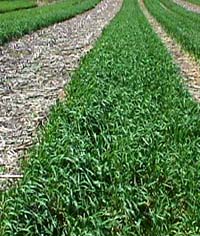No-Till Wheat Can Boost Yields of Subsequent Crops
No-Till Wheat Can Boost Yields of Subsequent Crops

In 1997, the Kentucky Small Grain Growers Association set a goal of having 75 percent of the state's wheat crop planted using no-till methods by 2005.
Today, between 25 and 35 percent of Kentucky's wheat crop is planted using no-till production. Many farmers have been skeptical about no-till wheat production and feel significant yield losses occur when using the practice.
Research done by specialists at the University of Kentucky Research and Education Center at Princeton in coordination with the Kentucky Small Grain Growers is showing little overall economic difference between the two cropping systems.
However, when succeeding crops are figured into the mix, no-till wheat provides an economic boost in the overall cropping cycle, said Lloyd Murdock, Extension soils specialist.
When no-till wheat was grown, the no-till corn and soybeans had 8.6 percent and 3.3 percent greater yields respectively than when these no-tilled crops were grown after tilled wheat.
In research studying why that is occurring, it has been found that there is more moisture in the soils of crops planted behind no-till wheat than those planted behind tilled wheat. Research is also being conducted on the soil composition. Specifically it is looking at what impact a complete cropping cycle using only no-till has on pores within the soil that aid in the retention and availability of water.
Eight years of data has shown that no-till wheat can produce on par with conventionally tilled wheat when properly managed. Additional nitrogen, seed rates and weed control appear to be where the greatest changes are needed but savings from not tilling offset those costs.
For some farmers the erosion control and a lesser workload during a busy time of year is what no-till offers as added incentives.
Murdock said he would encourage farmers thinking about no-till wheat to look at the advantages it provides for their entire cropping rotation.
"That's where the money is," he said. "If you look at no-till wheat by itself, there's no economic advantage. Time and labor savings and erosion control are the only things that might push a farmer that way but that might not be important. But the money from corn and soybeans would be."
Murdock said farmers who no-till wheat believe the boost to subsequent crop yields are there. A study will begin this year on several farms between Christian and Marion counties that will follow the cropping cycle through wheat, corn and soybeans. The study is a cooperative effort between UK and wheat consulting firms in Kentucky. Murdock said he'd like to see the study done for a minimum of four years.
Moving from research plots to on-farm studies allows farmers to see how the system would work at different locations with varying soil types.
The biggest problem in planting no-till wheat is planting into fields where crop residue is uneven making seed depths uneven. Plants put into the ground too shallow are more susceptible to freeze damage. Having a combine that spreads the residue evenly across the area is helpful in achieving a more uniform planting depth.
Mulching corn stalks versus planting into standing stalks have shown little difference, however when planting into standing stalks, it is best to plant at an angle from the corn row, Murdock said.
What impact stand has on yields is just beginning to be studied, but the early research is showing a perfect stand isn't necessary.
"We've convinced ourselves that we've got to have an almost perfect stand and so if we see some skips it bothers us and of course it's just pretty," Murdock said. "But in no-till wheat we don't have perfect stands."
Research by Murdock and Extension Grain Specialist James Herbek in 2000 showed that yields were not impacted with five and even 10 percent of an area skipped. These locations had almost exactly the same yields as locations with no skips. Areas with 15 percent of the area skipped did show yield differences, Murdock said.
While the data was for only one year, Murdock said he believes subsequent research will conclude that perfect stands may not be necessary.
"It boils down to we don't have to be as perfect as we thought," he said. "It's just aesthetics."
